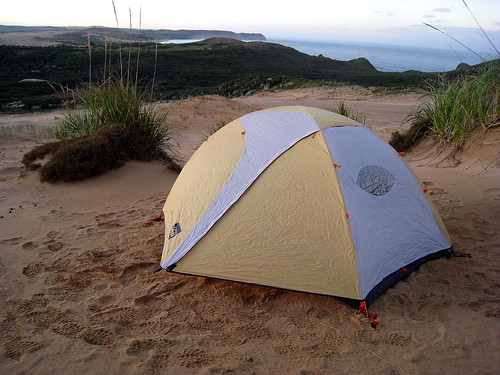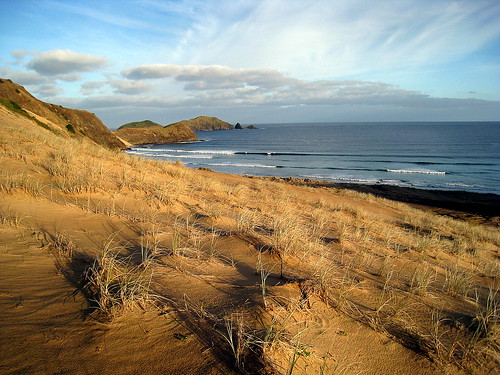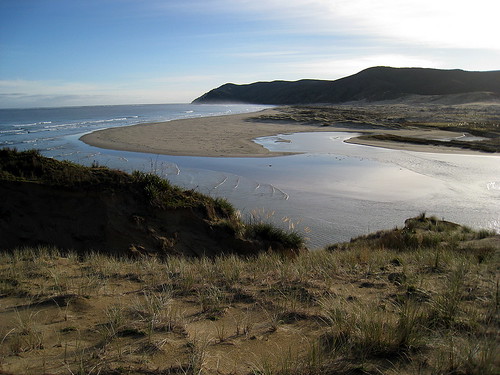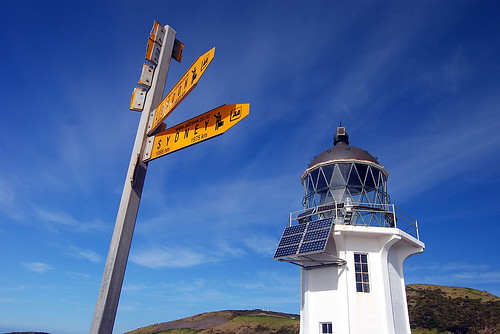day 2 photo set
We drag ourselves up as early as we can. I set the alarm for 5:45, but as it's not even dawn til 7am, we don't drag ourselves up for an hour. 2 more alarms do little to stoke our enthusiasm. Stuffing tent and bags into our packs, we trudge forward, eating cereal bars and hurrying towards our first water crossing.
In daylight, the next marker, the one we could not find last night, is blatantly obvious, and we trudge along the trail as rapidly as we are able. Our shoulders hurt from the heavy packs and poorly adjusted straps of yesterday. We're still in the sand dunes and coastal, beach-grass covered hills. The path continues to be nothing more than untracked dunes, rosy-tinted in the early morning sun, and regular orange-capped signposts. Behind us lies Cape Maria Van Diemen with its twin (old and new) lighthouses. We parallel the coast for a ways, following the trail along the top of the hills. A pod of dolphins pops to the surface periodically in the cove below us.
We resist clambering down to the beach for a closer look and continue up and over the next low headland, coming at last into sight of the estuary. It's well after 7am, and the tide is coming in fast. From our vantage point high on a bluff, the estuary doesn't look rough or deep, except perhaps at its mouth. We follow the trail over to where the usual crossing would be, but the climb down to the water is more difficult than expected and the incoming surf is stronger than anticipated.
Backtracking inland, we make our way through a swamp to an easier crossing spot. Thankfully it's relatively calm here. We wade across the cold waterway and pause upstream to refill our water bottles.
It's our first field-test of the water filter, and it seems to perform admirably. We get a pot of tea going, and then stock up on water. Meanwhile a pied shag wanders by and checks us out, followed by a small flock of ducks. We barely get the water bottles filled before a strong tide sweeps up the estuary and over its banks, nearly swamping our equipment. We move uphill a few feet, then sit and drink our tea. The occasional strong tide seems to come every 5 minutes or so, and I wonder at the reasons for its apparent periodicity.
After finishing our tea, we climb back to our feet, refreshed, and head down Te Werahi beach. It's quite pretty, but by the end, we are once again tired of walking on a beach.
At the end of the beach we are confronted with our second tide-dependent water crossing of the day. The trail up to Cape Reinga lighthouse leads around the tall bluffs on the west edge of the headland and up a steep track. Perhaps at low tide one could walk casually to this part of the trail, but now it's necessary to thread our way up and down over large slippery rocks and outcrops, and to time our crossings so as not to be swamped by the larger waves. Christina loses her balance and crashes down early on, then gets caught by an eager wave and half-soaked. I get a little wet, but nothing like Christina. Regardless, she carries on without complaint and we eventually make our way to the protected inlet at the bottom of our coming steep climb. The air is thick with the stench of rotting kelp, and we regroup hurriedly, then begin the ascent.
It's a steep climb and we are both ready for a break. The original trampers must have had iron muscles and an unending appetite for views. Every leg of the tramp is either along the top of a 1000-foot ridge or a steep ascent towards or away from one. After a time we come into hearing and sight of the Cape Reinga lighthouse park. A group of schoolkids is up there yelling and running and generally having a good field trip. It's all rather surreal after the last couple of days. Bus rides and teachers and packed bologna lunches seem a million years ago at this point.
Finally we climb up the last switchback of the trail and arrive at the restrooms. We walk over to the park map signs and sit on the grass to eat lunch and look out at the ocean. A few minutes down a narrow paved road, the schoolkids ruckus around the Cape Reinga lighthouse.
We chew through part of a big stick of pepperoni and some crackers while the occasional tourist or schoolkid wanders curiously past. By the time we are done with lunch, the lighthouse is almost deserted. We walk down to it and read the signs, take a few pictures, and look out at the endless ocean. Below us on the last bit of land is the tree where Maori believed their ancestors went to jump off to the netherworld when they died. Here, too, the Pacific and Tasman seas meet. The ocean is very rough, and the sight of one set of waves crossing paths at almost right angles to another set of waves is startling.
After a few minutes we walk slowly back up the road. At the top, we pass a couple of people from a construction crew. The whole Cape Reinga site is being redesigned. The car park and the restrooms are being moved, and we struggle to find the starting point for the rest of the trail. Eventually we run into the same construction crew, who point out the half-hidden entrance. Meanwhile a german couple pauses to ask us how long it takes to walk down to Te Werahi, as they are interested in camping. We give honest answers and urge them to be careful with the tides.
We are on our way out of the car park and down from Cape Reinga. The surrounding hills are steep and thick with regernating bush. It's late in the day and we hurry in the fading reddish light. The whole world is that rosy hue it turns sometimes before sunset. Our legs are weary and we stumble down the steep ridgeline towards our campsite on Tapotupotu Beach.
We turn inland for perhaps a hundred meters, walk through dank brush, and come into the campsite in the growing dusk.
It's a regular DOC campsite. There's a road to it and a couple of campervans already parked. We struggle up the road to the tent sites, drop our bags, then investigate the facilities. The usual long drop and non-potable water supply round out our list of luxuries for the night. We eye the tidal estuary in the middle of a huge sand bar. It's our first challenge for the morrow. I put up the tent while Christina rummages for our dinner. We barely manage to get these tasks done before collapsing, and determine that cooking chicken curry noodles in our tent - no matter how bad the mosquitoes - is always a mistake. I wander over to the estuary immediately east of the campsite and investigate how rapidly it's rising. In the dim glow from my flashlight, it's obvious that the intervening hour has added at least 50 feet to its width. Though the other campers twice invite us to join them at a bonfire on the beach, we decline. We have to cross the estuary early tomorrow and can barely keep our eyes open.






3 comments:
Were you at all tempted to catch a ride with the campervans? I think I would've been after two exhausting days like that.
You must've made an interesting addition to the field trip.
"And on your left, children, two backpackers. Notice the haggard faces and bleeding feet? You'll see this species frequently in the area. It's best not to get too close, though, or they may try to take your bologna."
haha - yes I think we quite amused the school kids! they all waved to us as they walked by - we were sitting down eating our lunch. the older tourists were curious about us too.
We were a little tempted to try and hitch a ride back, but both of us were much too stubborn to give up. At this point I think we both also felt like we were over the hump. It wasn't really true, but we felt that way.
And yeah, we got quite a few curious looks from the passerby. The natives were used to it, but the other tourists were kind of confused.
Post a Comment